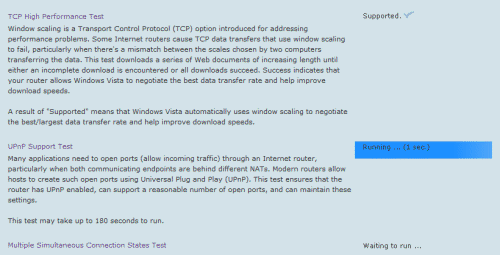Microsoft Internet Connectivity Evaluation Tool
If you’re running Windows Vista, this tool can verify whether your existing Internet router supports advanced features, such as improved download speeds. The tool is intended to be run from a home network behind a home Internet (NAT) router. Running this tool from behind a corporate firewall or on operating systems other than those specified above won’t produce accurate results. The tests can require up to 10 minutes to complete and do not make any permanent changes to your router nor to your operating system. For the most accurate results, your computer should be connected directly to your Internet router, using a wired connection.
The results of the Internet Connectivity Evaluation Tool look like this:
Privacy note: During testing, the tool contacts a Microsoft server and sends information about your computer (“standard computer information”). This information is only needed as part of the standard Internet protocol and generally is not personally identifiable. Standard computer information typically includes information such as your Internet Protocol (IP) address; operating system version; browser version; your hardware ID, which indicates the device manufacturer, device name, and version; and your regional and language settings.
The tests being performed
Basic Internet Connectivity Test – Duh… A result of “Supported” indicates that your computer has basic Internet connectivity.
Network Address Translator Type – Routers providing NAT support assign private IP addresses on the local network. NAT maps these private addresses on the inside network to a public IP address on the outside network so that computers behind the Internet router can communicate with the rest of the Internet. There are several types of NAT, and success of this test means that your Internet router or firewall allows applications which use Internet Protocol version 6 (IPv6) to connect, regardless of your ISP’s IPv6 support.
A result of “Not supported” in this test does not impact your basic Internet connectivity, it means, however, that your router cannot pass IPv6 tunneling over IPv4.
Traffic Congestion Test – Internet routers sometimes lose information that is being transferred across the Internet when they experience congestion (full router queues). This loss of information is known as packet loss. Internet protocols like the Transport Control Protocol (TCP) can use packet loss as a congestion indicator. Explicit Congestion Notification (ECN) is a mechanism that provides routers with an alternate method of communicating network congestion. This notification effectively reduces TCP retransmissions and increases throughput. If the test passes, it indicates that your Internet router successfully allows packets through with ECN options set.
A result of “Supported” indicates that your router can work with this new Vista Feature to improve download speeds and increase endpoint connection reliability.
Note: You would need to explicitly enable ECN on Vista to take advantage of this feature. In order to do so, open Command Prompt as an administrator (right-click > Run as administrator), and type:
netsh interface tcp set global ecncapability=enabled
If this test gives a result of “Not supported” and ECN is enabled, Windows cannot use ECN to detect network congestion and optimize downloads. However, your basic Internet connectivity should not be affected.
TCP High Performance Test – Window scaling is a Transport Control Protocol (TCP) option introduced for addressing performance problems. Some Internet routers cause TCP data transfers that use window scaling to fail, particularly when there’s a mismatch between the scales chosen by two computers transferring the data. Success indicates that your router allows Windows Vista to negotiate the best data transfer rate and help improve download speeds.
A result of “Supported” means that Windows Vista automatically uses window scaling to negotiate the best/largest data transfer rate and help improve download speeds.
Note: Although TCP Windows Scaling is enabled on Vista, some older routers and firewalls might not handle window scaling correctly (that is why you’re running this test in the first place – to determine if your router supports these advanced features or not). Therefore, if your router is unsupported, you might be better off by disabling TCP Windows Scaling. In order to do so, open Command Prompt as an administrator (right-click > Run as administrator), and type:
netsh interface tcp set global autotunninglevel=disabled
To re-enable type:
netsh interface tcp set global autotunninglevel=normal
If window scaling is not supported, your router cannot take advantage of network performance improvements for large file transfers. However, your basic Internet connectivity should not be affected.
UPnP Support Test – Many applications need to open ports (allow incoming traffic) through an Internet router, particularly when both communicating endpoints are behind different NATs. Modern routers allow hosts to create such open ports using Universal Plug and Play (UPnP). This test ensures that the router has UPnP enabled, can support a reasonable number of open ports, and can maintain these settings.
If this test does not succeed, experiences using certain programs may be degraded. However, your basic Internet connectivity should not be affected.
Multiple Simultaneous Connection States Test – This test creates 80 concurrent TCP connections to external Web servers and keeps them alive over the period of two minutes by attempting continuous data download using HTTP. Some routers might not have the necessary resources to keep many connections alive, and this is most common with low-grade home routers. Passing this test indicates that your router robustly supports multiple computers or programs accessing the Internet simultaneously.
A result of “Supported” means that your Internet router can handle a large number of simultaneous connections. This will enable you to connect to the Internet reliably using multiple applications or multiple computers. Also, your experience with applications that use multiple network streams (like some file download/sharing programs) will be enhanced.
If this test does not succeed, certain applications which use multiple network streams may run in a degraded manner, or you may have difficulties when using many Internet applications at the same time. However, basic Internet connectivity should remain unaffected.
See my Vista section for more articles about network optimization in Windows Vista.




